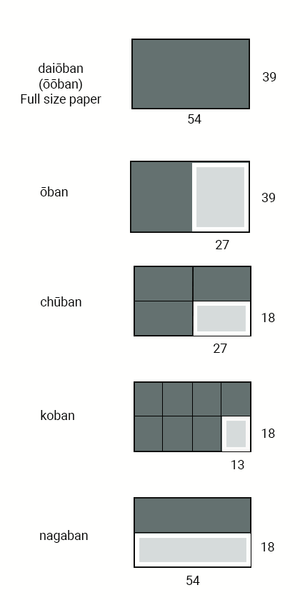- The paper size may differ depending on the location in which it was produced.
- Over time, certain sizes became more popular than others. Also, particular publishers favoured specific full-size sheet sizes, because they were more easily sold.
- The woodblock prints were cut into different sizes after printing.

During the early 18th century, larger sizes lost their popularity and the hosoban and chūban became the most popular sizes. One reason for this was due to publishers seeking a faster and easier sale.
The sizes are generated from the standard paper shōhōshō:
- daiaiban (full-size paper): 47 x 33 cm
- chūban (medium size): 16 x 23 cm
- hosoban (small vertical print): 33 x 15 cm, often used for single actor portraits of the Katsukawa School. Originally, three were cut on one block and then divided after printing. It is very rare to find three hosoban prints still in a single block.
From about 1780, ōban was the most common size. It originates from the standard paper daihōsho with the full-size daiōban (see picture). Some sizes, like ōban, have been used vertically (yoko-e) and horizontally (tata-e).
You can see in the picture how sizes like Oban, Chuban and Koban (from the standard paper daihōsho) measure (in cm). Please remember that original Japanese woodblock prints are handmade antiques, therefore the sizes shown are an average.
Single ōban size sheets have been put side by side: Diptych (a composition complete in two sheets); Triptych (a composition of three oblong prints); Pentaptych (a composition consisting of five sheets).
Vertical pictures
Hashira-e or Kakemono-e
It’s not easy to differentiate between harshira-e and kakemono-e. Both are long and narrow, intended to hang from the pillars (hashira) of a Japanese house to decorate living rooms. The sheets most used as hanging scrolls, differ in size dramatically. Heights between 68 and 73cm and widths between 12 and 16cm were the most common from 1670.
Very few examples have survived to the present day and these are often discolored by woodsmoke. Some were printed entirely on one sheet, but later examples, such as those from the early nineteenth century by Shunsen, Eizan and Eisen are often on two joining sheets. Kakemono is usually found to be wider than hashira-e and is typically produced from two ōban sized sheets, making the width between 25 and 30cm.
Tanzaku (tan - short, zaku - piece): narrow slips, like miniature kakemono-e, on which poems were inscribed. Used by Hiroshige for thumbnail sketches of birds and flowers, slight figure-studies, etc. Can vary in size:
- ōtanzaku: 39 x 18 cm
- chūtanzaku: 39 x 13 cm, 36 x 16 cm
- shōtanzaku: 39 x 8 cm, 33 x 11 cm, 24 x 12 cm
The sizes of surimono can vary, this is because they would have been ordered for special occasions.


